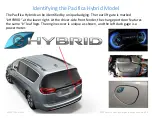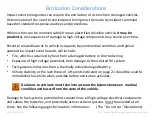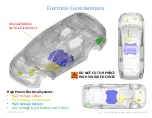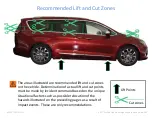
Fire Fighting Considerations
2017 Pacifica Hybrid Emergency Response Guide P.17
Fighting electrified driveline vehicle fires poses unique challenges.
•
Never cut, pierce or damage any high voltage component as serious injury may result.
•
Chemical extinguishers and oxygen denial are not effective in these fires.
•
Deluge with water delivered via fire hose at the maximum possible distance is the
recommended practice to contain the fire and cool the reagents, minimizing risk of spread
and risk of toxic emissions. This should continue after extinguishment until the pack is cool.
•
Application of large amounts of water should begin at the first signs of battery smoke as
water may absorb some harmful toxic emissions in the smoke.
•
Ventilation of the passenger compartment, if occupied, is essential at the first sign of
battery heating, smoke or fire. Batteries should be thermally assessed during initial
operations and throughout rescue and remediation efforts.
•
Damage, abuse, flooding or exposure to heat (such as from a vehicle fire) can initiate
thermal reactions which will advance to a significant fire in lithium ion power systems.
•
The Battery thermal reactions become self-sustaining at higher temperatures due to the
emission of oxygen from certain constituents.
•
Ongoing battery fire or heat production can facilitate the re-ignition of combustible
automotive components above and adjacent to the pack.
•
Lithium-ion automotive batteries can reignite due to ongoing reactions from internal heat.
•
For any battery thermal event, NFPA recommends SCBA be required within fifty feet.
Rescue of persons at risk and containment of the fire with prevention of toxic gas emissions
should be the goals of fire-fighting efforts.
©2017 FCA US LLC







































